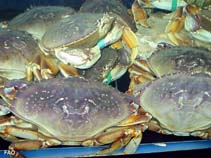Metacarcinus magister (Dana, 1852)
Dungeness crab| Native range | All suitable habitat | Point map | Year 2050 |

|
| This map was computer-generated and has not yet been reviewed. |
| Metacarcinus magister AquaMaps Data sources: GBIF OBIS |
Classification / Names Tên thường gặp | Các synonym ( Các tên trùng) | CoL | ITIS | WoRMS
Malacostraca | Decapoda | Cancridae
Environment: milieu / climate zone / Mức độ sâu / distribution range Sinh thái học
; Thuộc về nước lợ; Mức độ sâu 0 - 360 m (Tài liệu tham khảo 865). Temperate; 3°C - 19°C (Tài liệu tham khảo 104779), preferred 9°C (Tài liệu tham khảo 107945); 61°N - 23°N, 179°W - 110°W
Distribution Các nước | Các khu vực của FAO | Các hệ sinh thái | Những lần xuất hiện | Những chỉ dẫn
Eastern Pacific: Aleutian Islands, Alaska to Magdalena Bay, Mexico. Subtropical to boreal.
Length at first maturity / Bộ gần gũi / Weight / Age
Chín muồi sinh dục: Lm ?, range 10 - ? cm Max length : 22.5 cm CW con đực/không giới tính; (Tài liệu tham khảo 865); 16 cm CW (female); Tuổi cực đại được báo cáo: 10 các năm (Tài liệu tham khảo 104779)
Life cycle and mating behavior Chín muồi sinh dục | Sự tái sinh sản | Đẻ trứng | Eggs | Sự sinh sản | Larvae
Main reference
Các tài liệu tham khảo | Người điều phối | Người cộng tác
Shirley, S.M., T.C. Shirley and S.D. Rice 1987 Latitudinal variation in the Dungeness crab, Cancer magister: zoeal morphology explained by incubation temperature. Mar. Biol. 95(3):371-376. (Tài liệu tham khảo 8391)
IUCN Red List Status
(Tài liệu tham khảo 130435: Version 2025-1)
CITES status (Tài liệu tham khảo 108899)
CMS (Tài liệu tham khảo 116361)
Threat to humans
Human uses
Các nghề cá: Tính thương mại
FAO - Các nghề cá: landings, species profile | FishSource | Biển chung quanh ta
Các công cụ
Thêm thông tin
Max. ages / sizes
Length-weight rel.
Length-length rel.
Length-frequencies
Mass conversion
Sự phong phú
Các nguồn internet
BHL | BOLD Systems | CISTI | DiscoverLife | FAO(Các nghề cá: species profile; publication : search) | Fishipedia | GenBank (genome, nucleotide) | GloBI | Gomexsi | Google Books | Google Scholar | Google | PubMed | Cây Đời sống | Wikipedia (Go, tìm) | Tạp chí Zoological Record



